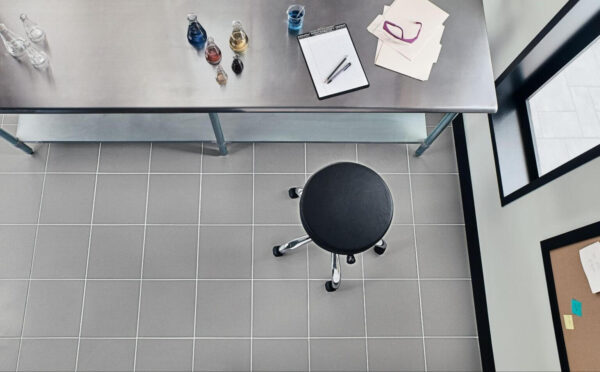Ceramic tile is a trusted choice for educational facilities, helping to create learning environments worthy of students’ creativity and ambitions. Read on to learn more about the benefits of ceramic tile for schools and other educational facilities, as well as the specific spaces in which ceramic tile provides a clear advantage.
Benefits of Ceramic Tile for Educational Spaces
According to a National Center for Education Statistics (NCES) survey the average age of school buildings in the U.S. is 44 years old.
Considering the gap in funding to meet infrastructure needs, when schools finally have funding to improve or build new facilities, a prime objective should be to make the funding serve as long as possible. This starts with choosing time-honored building materials, such as ceramic tile.
The family of ceramic tile products, which includes quarry tile, ceramic tile, and porcelain tile, tops the list of having the lowest life cycle costs of flooring materials for commercial buildings. This alone makes durable ceramic tile materials a smart investment for educational facilities that need to stand up to decades of heavy use.

Ceramic tile’s wide range of color and shape options creates a cheery and easy-to-clean preschool environment.
Durability
Let’s take a closer look at the durable benefits of ceramic tile:
- Scratch resistance: Ceramic tile resists scratches, cuts, scrapes, dents, and dings even after years of heavy foot traffic.
- Water resistance: Ceramic tile is part of a waterproof installation system so that there’s no worry about water seeping through seams and ruining the flooring’s underlayment. This makes ceramic tile a great choice for everything from bathrooms and locker rooms to the cafeteria, kitchen, and science labs.
- Stain resistance: Messes are a given in educational environments, and especially in daycares and primary schools. Fortunately, ceramic tile resists stains and often needs nothing more than water for easy cleaning.
- Fade resistance: Ceramic tile won’t fade from exposure to the sun, harsh cleaning products, or heavy foot traffic — ensuring facilities will continue looking their best for decades.
Low Maintenance
Low maintenance isn’t just a nice-to-have desire for school systems. Considering budget constraints and the increasing pressure to maintain hygiene post-pandemic, low-maintenance cleaning is essential.
Water alone is often enough to clean tile. If you need to clean up stronger messes, consult the manufacturer for guidelines. Generally, a cleanser made for tile and grout or a neutral ph cleanser is best for cleaning tile.
Of course, the Centers for Disease Control (CDC) does recommend routine disinfecting of schools to reduce the spread of germs. Fortunately, when cleaning staff need to use specific cleaning products to disinfect, they won’t damage ceramic tile.
Safety & Hygiene
Perhaps the most important consideration when designing educational spaces consists of safety and hygiene — essentially synonymous today. Ceramic tile starts off on the right foot with numerous health benefits that help maintain a hygienic environment.
Public health demands materials that are not just easy to keep clean but that are inherently healthier building materials.
Ceramic tile makes the choice easy by providing numerous health benefits. For example, ceramic tile is:
- Bacteria-resistant, creating a surface that’s inhospitable to the growth of bacteria and other microbes
- Available in antimicrobial options that can suppress and even destroy harmful microorganisms such as bacteria, viruses, mold, and fungi
- Hypoallergenic, with a hard surface that doesn’t trap allergens
- Free of volatile organic compounds (VOCs), formaldehyde, and plastic
- Made of naturally occurring materials
Ceramic tile is also fire-resistant, meaning that it will not burn, produce smoke, or give off toxic fumes in the case of a fire. Ceramic tile can even help maintain a clear exit path for staff and students.
Additionally, ceramic tile has a variety of slip-resistant options — especially important in areas that may be exposed to wet conditions, such as entrances and hallways, commercial kitchens and cafeterias, bathrooms and locker rooms.
Design

Clemson University incorporates team spirit and school colors in the ceramic tile used for their sports training facility.
Studies show that interior design can actually impact students’ health, behavior, and performance.
For example, bright warm colors have been shown to stimulate the autonomic nervous system, whereas soft cool colors slow it down. These responses can affect students’ mood, attention, energy, productivity, and accuracy — all essential for academic performance.
Ceramic tile makes it easy to optimize schools’ interior design while also meeting the functional needs discussed above. Choose from options for tile colors, sizes, shapes, and textures as well as custom designs to create an environment that promotes learning and even reflects school spirit. Imagine a tile mosaic in the shape of a mascot, or geometric algorithms in a school’s colors lining the hallways.
Promote school spirit with tile design and do more than create a visually appealing space: According to an online poll, students with school spirit perform better academically, are more civically and socially engaged, and are even happier. Who wouldn’t want that for their student body?
Sustainability
- Ceramic tile in a school library is both a highly stylish and a highly functional choice.
- Ceramic tile in school bathrooms and locker rooms provides easy cleaning for maintenance staff.
- Experiment with confidence when ceramic tile is protecting the floor.
What better way to show students respect for the environment than incorporating sustainability into the very design of their schools?
As the K12 Facilities Forum, a community for facilities and operations leaders from the top school districts in the U.S., points out: “The call to incorporate greener elements is amplifying with the recognition that learning and academic performance is closely tied to the built environment.”
What’s more, students themselves are concerned about sustainability. In a 2020 global survey of nearly 7,000 higher education students, 92% of respondents agreed that all universities and colleges should actively incorporate and promote sustainable development.
Ceramic tile simplifies sustainable development by combining the above benefits with numerous eco-friendly features. For example, ceramic tile is:
- Made from naturally occurring and indigenous raw materials, significantly decreasing emissions and energy from long-distance shipping
- Incredibly durable, allowing tile to be used for generations without replacement and minimizing environmental impact
- Energy-efficient, reducing the draw on HVAC systems
- Available in options made from pre- and post-consumer recycled content
- Salvageable during renovations and capable of being repurposed for other projects
- Qualifies for clean fill, meaning it won’t leach caustic liquids or decompose when disposed of
- Reusable in paving and asphalt applications when ground up
Where to Use Tile in Educational Spaces
- Outdoor common areas can expand an educational facility’s learning and operational space.
- Porcelain tile used for a library building façade provides a beautiful exterior.
- Ceramic tile gets an A+ for creating high-performance environments.
Ceramic tile’s many benefits lend themselves to a variety of educational facilities, from preschools to universities. They are a great option for both indoor and outdoor spaces.
The many benefits of ceramic tiles lend themselves to a variety of educational facilities, from pre-schools to universities. Whether for indoor or outdoor spaces, ceramic tiles are the perfect choice.
Stain-resistant, fire-resistant and easy to clean, they can be installed in cafeterias, labs, bathrooms and changing rooms, for example. Resistant and durable, they are also a great choice for common areas such as corridors, libraries and classrooms.
Many educational units still take advantage of the thermal and acoustic insulation, unique style options, durability, and weather protection of ceramic tile for a building façade or a sport facilities.
Text: WhyTile.com













